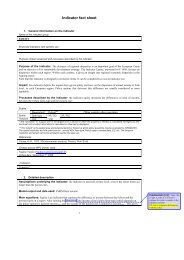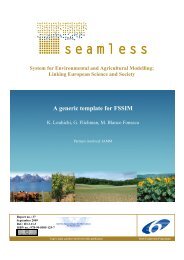Farming Systems Design 2007 - International Environmental ...
Farming Systems Design 2007 - International Environmental ...
Farming Systems Design 2007 - International Environmental ...
Create successful ePaper yourself
Turn your PDF publications into a flip-book with our unique Google optimized e-Paper software.
<strong>Farming</strong> <strong>Systems</strong> <strong>Design</strong> <strong>2007</strong><br />
Field-farm scale design and improvement<br />
High elevations in this region (1200 to 1500 meters above sea level) cause cool temperatures and<br />
short growing seasons. The average frost-free period is about 125 days and average annual<br />
precipitation is 300 to 400 mm. Over 75 percent of precipitation comes during the growing season<br />
from thunderstorms that can be extremely heavy. Strong winds in winter and spring dry out soils<br />
and can damage crops. Soils are typically deep loams with native soil organic matter content of<br />
about one percent, but 60 percent has been lost from farmlands due to cultivation over the last 100<br />
years (Aguilar et al., 1988). The majority of agricultural production is dryland winter wheat-fallow<br />
rotation systems. Beef cattle production is important near native rangelands. Irrigation is generally<br />
limited to flood plains of tributaries to the Platte River and is used mostly for winter livestock feed.<br />
The SAREC farm was established in 2001 for discovery, dissemination, and dialogue of integrated<br />
agricultural systems. The farm is in Goshen County, Wyoming, on 1570 ha, with 154 ha irrigated<br />
croplands, 617 ha unirrigated croplands, and 775 ha native rangelands. Facilities include a beef<br />
herd with feeding facilities, laboratory and dormitory facilities, and equipment for field experiments.<br />
The <strong>Farming</strong> <strong>Systems</strong> Project will occupy 170 ha for assessing conventional, reduced-input, and<br />
organic approaches toward integrated dryland crop, irrigated crop, and livestock production. Each<br />
of the three approaches will occupy six ha of range, dry crop, and irrigated land randomly located<br />
in three replication clusters. Half of each six-ha plot will be long-term baseline operation, with<br />
annual crops, perennial forages, and pasture under the conventional, reduced-input, or organic<br />
approach. The other half of each plot is for shorter-term evaluation of variations to base systems.<br />
Results<br />
The project provides a framework for multidisciplinary problem-solving among producers,<br />
educators, and researchers. Involving producers ensures short-term changes in knowledge, skills,<br />
and attitudes and medium-term incorporation of that knowledge into on-farm decisions.<br />
Team building has fostered cross-discipline collaboration on a proposal to the US Dep. of<br />
Agriculture Western Region Sustainable Agriculture Research and Education Program. New<br />
channels of communication are yielding improved understandings. For instance, research team<br />
producers interested in organic production say they need information on how to economically<br />
survive the three-year transition period while building soil organic matter to improve yields without<br />
synthetic fertilizer. This issue is not currently being addressed for the Western High Plains region.<br />
Conclusions<br />
The high, cold, and dry climate makes farming precarious in the Western High Plains of the United<br />
States. Conventional farms with low yields depend on large scale to sustain profits in wheat-fallow,<br />
irrigated crops, and range livestock systems. Producers want to increase value and reduce costs,<br />
but transition to organic, or reduced-input systems involves uncertainties about short- and longterm<br />
sustainability. The <strong>Farming</strong> <strong>Systems</strong> Project was initiated for long-term evaluation of<br />
strategies for transition and operation of sustainable farming systems.<br />
References<br />
R. Aguilar et al., Effects of cultivation of soils in northern Great Plains rangeland, 1988. Soil Sci. Soc. Am. J.<br />
52,1081-1085.<br />
C. Dimitri and L. Oberholtzer, EU and U.S. organic markets face strong demand under different policies,<br />
2006. Amber Waves 4, 12-19.<br />
A. Elobeid et al., The long-run impact of corn-based ethanol on the grain, oilseed, and livestock sectors: A<br />
preliminary assessment, 2006. CARD Briefing Paper 06-BP 49. www.card.iastate.edu.<br />
J.E. Ikerd, The need for a system approach to sustainable agriculture, 1993. Agric., Ecosys., and Env. 46,<br />
147-160.<br />
J. Lewandrowski et al., Economics of sequestering carbon in the U.S. agricultural sector, 2004. TB-1909,<br />
USDA/ERS, April 2004.<br />
J.P. Mueller et al., Development and implementation of a long-term agricultural systems study: Challenges<br />
and opportunities, 2002. Hort Tech. 12, 362-368.<br />
C.R.W. Spedding, Agriculture and the citizen, 1996. Chapman Hall, New York.<br />
US <strong>Environmental</strong> Protection Agency, US Ecoregions, <strong>2007</strong>. http://www.epa.gov/wed/pages/ecoregions.htm.<br />
- 46 -




